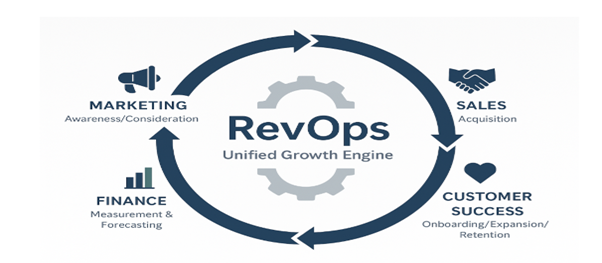Revenue Operations (RevOps) is not just a buzzword—it is a strategic framework that unifies go-to-market teams, aligns operations, and drives consistent, scalable growth. This blog will explain what RevOps means, what it is responsible for, and why it is becoming the backbone of high-performing organizations.
What is RevOps?
RevOps is the operational alignment of Sales, Marketing, Customer Success, and Finance at its core. It tears down the traditional silos that limit collaboration and efficiency, creating a unified engine focused on three key goals:
✅ Customer Experience
✅ Revenue Growth
✅ Profitability
Revenue Operations (RevOps) steers metrics, systems, and processes across the entire customer lifecycle, enabling teams to operate from a unified playbook and shared data set.
The RevOps Mandate
The mission of RevOps is clear:
- Align all revenue-driving functions across the customer lifecycle
- Own and unify metrics from awareness to advocacy
- Optimize tools and systems for seamless collaboration
- Lead change management to adapt and scale effectively
RevOps creates a single source of truth and a culture of cross-functional accountability by doing this.
Core Responsibilities
RevOps is not just about high-level strategy—it is deeply operational. It owns the Standard Operating Procedures (SOPs) for every phase of the customer journey:
🔹 Marketing
- Awareness → Consideration
🔹 Sales
- Acquisition → Close
🔹 Customer Success
- Onboarding → Expansion → Retention
🔹 Finance
- CAC analysis, profitability tracking, and consistent forecasting
Standard Operating Procedures (SOPs)
RevOps builds, documents, and enforces the GTM strategy by:
- Designing and executing both strategic and tactical programs
- Owning full-funnel metrics and reporting
- Ensuring alignment with the Product, Finance, and the Executive Team
- Leading operational change across departments
Enablement Across Teams
RevOps empowers teams by eliminating redundant processes and misaligned goals. It brings clarity and consistency to how each function contributes to revenue.
🔸 Marketing Enablement
- Strategic Planning & Budgeting
- Campaign & Lead Management
- Data Governance & Reporting
- Customer Marketing & ROI Metrics
🔸 Sales Enablement
- Sales Process Design & Adoption
- Forecasting & Metrics
- Territory Planning
- Proposal & Compensation Design
- Change Management for Sales Initiatives
🔸 Customer Success Enablement
- Onboarding, Upsell, and Renewal Programs
- Churn Forecasting & Risk Management
- CSM Capacity Planning
- Customer Journey Mapping
- Tool Management (Gainsight, Totango…)
Data & Analysis
RevOps eliminates “gut feel” decision-making by creating a shared, trusted data ecosystem.
- Standardizes metrics and definitions across teams
- Ends duplicative reporting
- Offers both day-to-day operational dashboards and long-term strategic insights
- Builds credibility and trust across all stakeholders
From Awareness to Advocacy
RevOps ensures every team contributes across the customer lifecycle:
- Marketing drives not just leads but retention, cross-sell, and upsell
- Sales engages across pre-sale and post-sale initiatives
- Customer Success owns long-term outcomes, tying success back to acquisition insights
This continuous engagement turns prospects into advocates—and drives sustainable growth.
Technology Ownership
RevOps consolidates the tech stack, ensuring tools are:
- Aligned to business needs
- Integrated across functions
- Properly governed and secured
- Fully adopted and enabled
This centralized ownership simplifies operations and reduces costs while maximizing value and usage.
In Conclusion: Why RevOps Matters
RevOps is more than a function—it is the operating system for modern revenue teams.
It unifies people, processes, data, and tools into a cohesive, aligned engine that drives growth from first touch to advocacy.
It replaces the fragmented models of Sales Ops, Marketing Ops, and CS Ops with a centralized team focused on scale, accountability, and predictable performance.
RevOps steers the entire revenue engine—from the cradle to the grave.

Leave a Reply